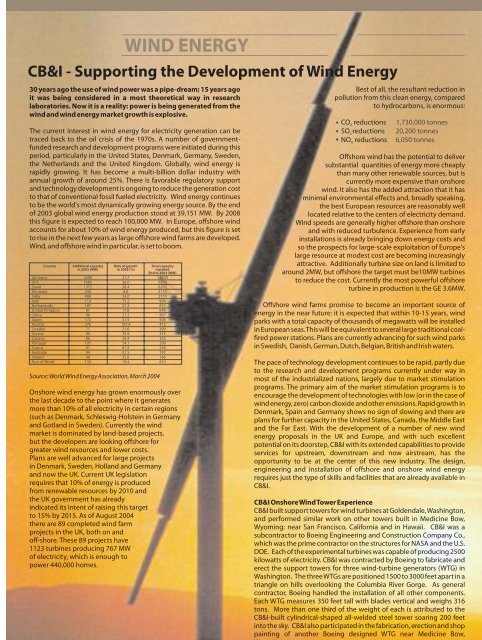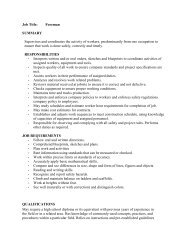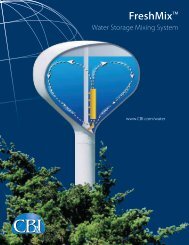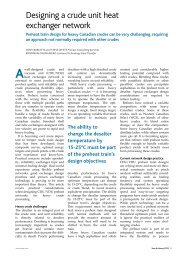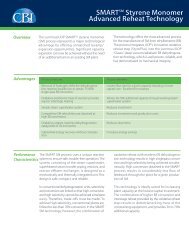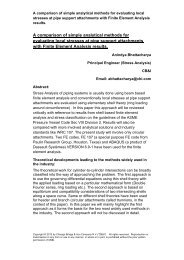In this issue - CB&I
In this issue - CB&I
In this issue - CB&I
You also want an ePaper? Increase the reach of your titles
YUMPU automatically turns print PDFs into web optimized ePapers that Google loves.
30 years ago the use of wind power was a pipe-dream; 15 years ago<br />
it was being considered in a most theoretical way in research<br />
laboratories. Now it is a reality: power is being generated from the<br />
wind and wind energy market growth is explosive.<br />
The current interest in wind energy for electricity generation can be<br />
traced back to the oil crisis of the 1970s. A number of governmentfunded<br />
research and development programs were initiated during <strong>this</strong><br />
period, particularly in the United States, Denmark, Germany, Sweden,<br />
the Netherlands and the United Kingdom. Globally, wind energy is<br />
rapidly growing. It has become a multi-billion dollar industry with<br />
annual growth of around 25%. There is favorable regulatory support<br />
and technology development is ongoing to reduce the generation cost<br />
to that of conventional fossil fueled electricity. Wind energy continues<br />
to be the world's most dynamically growing energy source. By the end<br />
of 2003 global wind energy production stood at 39,151 MW. By 2008<br />
<strong>this</strong> figure is expected to reach 100,000 MW. <strong>In</strong> Europe, offshore wind<br />
accounts for about 10% of wind energy produced, but <strong>this</strong> figure is set<br />
to rise in the next few years as large offshore wind farms are developed.<br />
Wind, and offshore wind in particular, is set to boom.<br />
Source: World Wind Energy Association, March 2004<br />
Onshore wind energy has grown enormously over<br />
the last decade to the point where it generates<br />
more than 10% of all electricity in certain regions<br />
(such as Denmark, Schleswig-Holstein in Germany<br />
and Gotland in Sweden). Currently the wind<br />
market is dominated by land-based projects,<br />
but the developers are looking offshore for<br />
greater wind resources and lower costs.<br />
Plans are well advanced for large projects<br />
in Denmark, Sweden, Holland and Germany<br />
and now the UK. Current UK legislation<br />
requires that 10% of energy is produced<br />
from renewable resources by 2010 and<br />
the UK government has already<br />
indicated its intent of raising <strong>this</strong> target<br />
to 15% by 2015. As of August 2004<br />
there are 89 completed wind farm<br />
projects in the UK, both on and<br />
off-shore. These 89 projects have<br />
1123 turbines producing 767 MW<br />
of electricity, which is enough to<br />
power 440,000 homes.<br />
WIND ENERGY<br />
CB&I - Supporting the Development of Wind Energy<br />
Country<br />
Germany<br />
USA<br />
Spain<br />
Denmark<br />
<strong>In</strong>dia<br />
Italy<br />
Netherlands<br />
United Kingdom<br />
China<br />
Japan<br />
Austria<br />
Sweden<br />
Greece<br />
Canada<br />
Portugal<br />
France<br />
Australia<br />
Ireland<br />
Rest of World<br />
Additional capacity<br />
in 2003 (MW)<br />
2608<br />
1685<br />
1372<br />
230<br />
408<br />
119<br />
187<br />
97<br />
99<br />
172<br />
276<br />
71<br />
99<br />
86<br />
105<br />
91<br />
94<br />
49<br />
133<br />
Rate of grpwth<br />
in 2003 (%)<br />
21.7<br />
36.0<br />
28.4<br />
8.0<br />
24.0<br />
15.2<br />
27.3<br />
17.6<br />
21.2<br />
51.5<br />
197.9<br />
21.6<br />
35.9<br />
36.4<br />
54.1<br />
61.5<br />
91.5<br />
35.8<br />
19.4<br />
Total capacity<br />
installed<br />
End of 2003 (MW)<br />
14609<br />
6370<br />
6202<br />
3110<br />
2110<br />
904<br />
873<br />
649<br />
567<br />
506<br />
415<br />
399<br />
375<br />
322<br />
299<br />
239<br />
197<br />
186<br />
819<br />
Best of all, the resultant reduction in<br />
pollution from <strong>this</strong> clean energy, compared<br />
to hydrocarbons, is enormous:<br />
CO<br />
2<br />
reductions<br />
SO2<br />
reductions<br />
NO<br />
X<br />
reductions<br />
1,730,000 tonnes<br />
20,200 tonnes<br />
6,050 tonnes<br />
Offshore wind has the potential to deliver<br />
substantial quantities of energy more cheaply<br />
than many other renewable sources, but is<br />
currently more expensive than onshore<br />
wind. It also has the added attraction that it has<br />
minimal environmental effects and, broadly speaking,<br />
the best European resources are reasonably well<br />
located relative to the centers of electricity demand.<br />
Wind speeds are generally higher offshore than onshore<br />
and with reduced turbulence. Experience from early<br />
installations is already bringing down energy costs and<br />
so the prospects for large-scale exploitation of Europe's<br />
large resource at modest cost are becoming increasingly<br />
attractive. Additionally turbine size on land is limited to<br />
around 2MW, but offshore the target must be10MW turbines<br />
to reduce the cost. Currently the most powerful offshore<br />
turbine in production is the GE 3.6MW.<br />
Offshore wind farms promise to become an important source of<br />
energy in the near future: it is expected that within 10-15 years, wind<br />
parks with a total capacity of thousands of megawatts will be installed<br />
in European seas. This will be equivalent to several large traditional coalfired<br />
power stations. Plans are currently advancing for such wind parks<br />
in Swedish, Danish, German, Dutch, Belgian, British and Irish waters.<br />
The pace of technology development continues to be rapid, partly due<br />
to the research and development programs currently under way in<br />
most of the industrialized nations, largely due to market stimulation<br />
programs. The primary aim of the market stimulation programs is to<br />
encourage the development of technologies with low (or in the case of<br />
wind energy, zero) carbon dioxide and other emissions. Rapid growth in<br />
Denmark, Spain and Germany shows no sign of slowing and there are<br />
plans for further capacity in the United States, Canada, the Middle East<br />
and the Far East. With the development of a number of new wind<br />
energy proposals in the UK and Europe, and with such excellent<br />
potential on its doorstep, CB&I with its extended capabilities to provide<br />
services for upstream, downstream and now airstream, has the<br />
opportunity to be at the center of <strong>this</strong> new industry. The design,<br />
engineering and installation of offshore and onshore wind energy<br />
requires just the type of skills and facilities that are already available in<br />
CB&I.<br />
CB&I Onshore WindTower Experience<br />
CB&I built support towers for wind turbines at Goldendale, Washington,<br />
and performed similar work on other towers built in Medicine Bow,<br />
Wyoming: near San Francisco, California and in Hawaii. CB&I was a<br />
subcontractor to Boeing Engineering and Construction Company Co.,<br />
which was the prime contractor on the structures for NASA and the U.S.<br />
DOE. Each of the experimental turbines was capable of producing 2500<br />
kilowatts of electricity. CB&I was contracted by Boeing to fabricate and<br />
erect the support towers for three wind-turbine generators (WTG) in<br />
Washington. The threeWTGs are positioned 1500 to 3000 feet apart in a<br />
triangle on hills overlooking the Columbia River Gorge. As general<br />
contractor, Boeing handled the installation of all other components.<br />
Each WTG measures 350 feet tall with blades vertical and weighs 316<br />
tons. More than one third of the weight of each is attributed to the<br />
CB&I-built cylindrical-shaped all-welded steel tower soaring 200 feet<br />
into the sky. CB&I also participated in the fabrication, erection and shop<br />
painting of another Boeing designed WTG near Medicine Bow,


